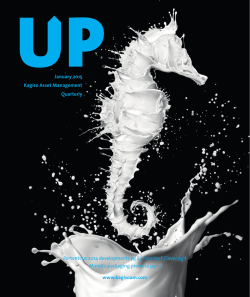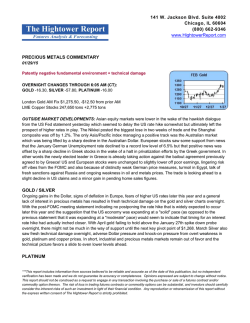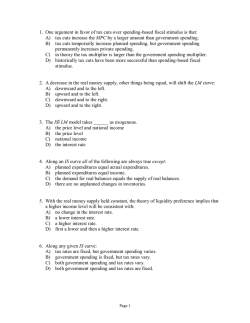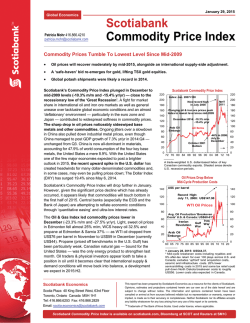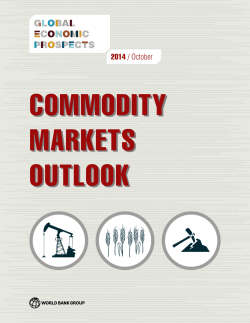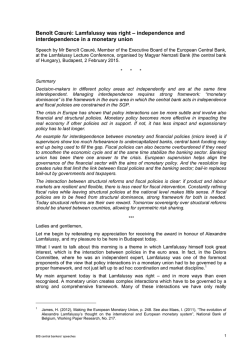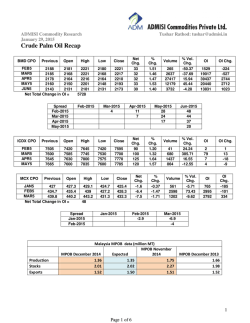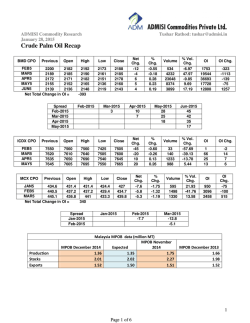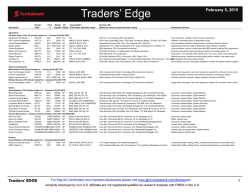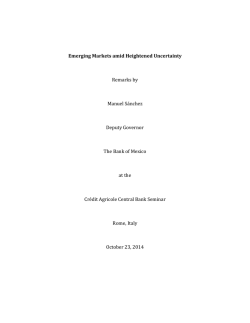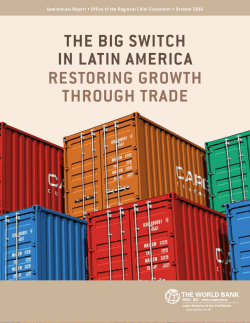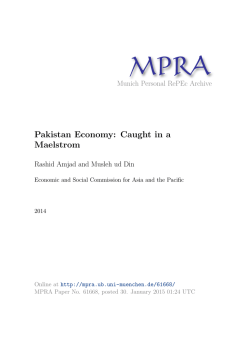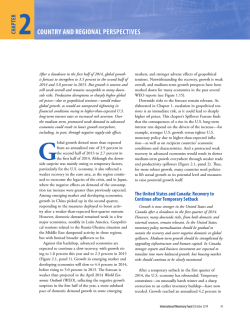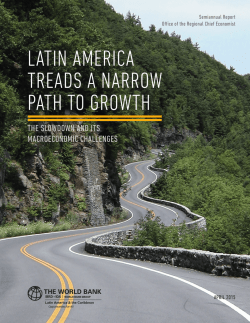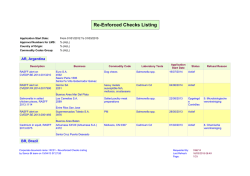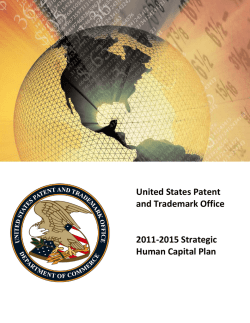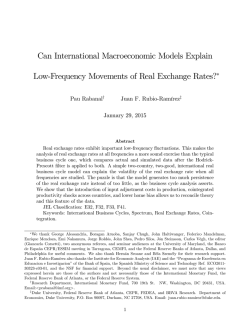
Anexo Material Solicitados
Commodity Prices and Macroeconomic Policy* XVIII ANNUAL CONFERENCE ON CENTRAL BANKING, ANALYSIS AND ECONOMIC POLICIES OPENING REMARKS Rodrigo Vergara Governor Central Bank of Chile October 2014 * Opening remarks delivered at the Eighteenth Annual Conference of the Central Bank of Chile, held on October 13, 2014, Santiago, Chile. I thank Rodrigo Caputo, Nicolás Rivera, Diego Saravia, and Consuelo Edwards for helpful comments. Good morning. Welcome to the Central Bank of Chile´s Eighteenth Annual Conference on Central Banking, Analysis and Economic Policies. Year after year, this event gathers an outstanding group of economists from academic and policy circles around issues at the forefront of the global discussion. This year, our conference focuses on the timely topic, “Commodity Prices and Macroeconomic Policy”. Commodity prices are very volatile and subject to structural breaks. In recent years they have been on a roller coaster. For example, in the second quarter of 2008 the oil price was as high as 124 dollars per barrel, and copper, the main Chilean export, had reached 3.83 dollars per pound. During the recent Global Financial Crisis both markets adjusted dramatically: in the first quarter of 2009 oil prices plummeted to 43 dollars per barrel and copper to 1.55 dollars per pound. Since 2009, commodity prices have recovered to pre-crisis levels, but in recent years they have reversed in what some see as the beginning of a declining trend. 1 The literature has tried to explain three important components of commodity price dynamics. First, the secular trend, which Prebisch (1950) and Singer (1950) have conjectured it should be declining, although there is no empirical evidence in this regard. Second, the long cycles that affects commodities’ relative prices, and finally the volatility which has been often found to be time varying and generally increasing in recent years.2 There is some consensus that fluctuations in commodity prices are generally associated to macroeconomic volatility. 3 These fluctuations pose important challenges for policymakers in both commodity-producing countries and in countries that are importers of those goods. In this context several policy-related questions emerge: 1. How should central banks react to persistent increases in commodity prices that affect CPI inflation? 2. In commodity-producing countries, what type of policies can avoid negative spillovers to the rest of the economy (what we know as the Dutch Disease)? 3. How should a country manage a windfall of commodities in order to smooth consumption over time? 1 IMF (2014) Arezki and others (2014). 3 Mendoza (1995); Kose (2002). 2 4. Is it possible to offset the depletion of non-renewable natural resources with the accumulation of other assets? 5. What are the direct interactions between the commodity sector and the rest of the sectors in the economy? These are all non-trivial questions, and this conference will provide some answers to them. Today I will discuss some of the issues that, I think, are among the most relevant in order to design efficient policy responses to commodity shocks. I will share some thoughts about what we know today and what the pending research agenda is in this topic. There is an extensive literature analyzing a long series of commodity prices. Although there is some controversy about the main drivers of the relative prices of commodities, there is consensus that, since the 19th century, four commodity “supercycles” have taken place. Typically, these events were related to a strong demand associated with moments of rapid industrialization and urbanization in major areas of the world. Those cycles, which lasted on average 20 years, ended once the supply of commodities increased to match the growing demand. 4 The current commodity supercycle, which began in the late 1990s, is associated with China’s industrialization and urbanization process. It also coincides with rapid growth in the other BRIC countries like India. In this cycle the real price of all commodities: energy, grains, oil and metals, rose substantially from 2000 to 2008. In the case of copper the price began rising in 2003-2004. At the onset of the Great Recession, commodity prices declined sharply, although they have recovered to fairly high levels since 2009. According to the recent World Economic Outlook, commodity prices are expected to decline in the near future as a consequence of a slowdown in emerging market economies. 5 It is not clear, however, whether we are experiencing the end of the current supercycle. 6 The present cycle poses several questions for inflation-targeting countries that import commodities. For these economies, a usual monetary policy prescription is to target core inflation (the CPI that excludes food and energy prices). In this setup, food and energy prices are assumed to be flexible, so no monetary intervention is required to stabilize them. The basis for this result 4 Canuto (2014). IMF (2014). 6 See, for example, Canuto (2014). 5 2 lies in some standard small open economy models in which core inflation targeting replicates the flexible price equilibrium, because domestic prices are assumed to be sticky. 7 Central banks, however, may react to commodity price changes for various reasons. One such reason would be that to avoid second round effects derived from commodity shocks, the monetary authority may react to large commodity price increases. This response anchors long-run inflation expectations, and could accommodate relative price changes. Recent theoretical contributions 8 also suggest that CPI inflation targeting could be desirable once exogenous commodity prices are introduced into the standard New Keynesian model. More specifically, when the variance of food price shocks is calibrated to be as large as in real world data, CPI targeting tends to induce more consumption per unit of domestic output, thus enhancing welfare. Similar prescriptions arise in some models in which price stickiness is present not only in domestically produced goods but also in imported goods. In this case it is efficient to target headline CPI inflation. 9 Now, for countries that base their exports on commodities, the policy challenges go far beyond inflation targeting. In this case, a relevant question is how to manage the windfall of commodities. The standard policy prescription is that countries should, optimally, save during commodity booms and run deficits when times turn bad. This policy is often implemented through countercyclical fiscal measures. The evidence, so far, suggests that in many countries fiscal policy was pro-cyclical during the commodity price booms of the 1970s and 1980s. That was not the case in the recent boom: in many countries – particularly in Latin America and the Middle East – extra revenues were saved as commodity prices increased. The result was a much larger budget surplus during the actual commodity price boom. 10 In Chile, the recent evidence points in the same direction: unlike in the past, during the last decades whenever the price of copper has increased above its long-run value, the fiscal authority has saved an important proportion of the proceedings. The reason for this behavior lies in a very 7 See, among others, Aoki (2001); Clarida, Galí and Gertler (2001); Galí and Monacelli (2005). See, for example, Catão and Chang (2012). 9 Engel (2011). 10 Céspedes and Velasco (2013). 8 3 prudent an austere fiscal policy in Chile during the last three decades. Its major focus has been that the windfall from the price of copper is saved. This started with the so-called Copper Compensation Fund in the mid-1980s whereby revenues coming form an increase in the price of copper above certain level were saved to be later used when the price dropped below a given level. Later, in 2001, a structural approach to fiscal policy conduct was adopted, in which not only the price of copper was included but also the cyclical state of the economy in a much more formal approach. As from that year, the budget is based on a structural or cyclically-adjusted fiscal balance. Interestingly, the two key variables in this new fiscal rule, the long term price of copper and the cyclical position of the economy (or, more precisely, the output gap) are estimated by independent committees. This avoids the usual temptation of policymakers to be over-optimistic 11 about the variables that determine structural revenues so as to have more expenditure room. It is worth noting that it has been very frequent in Latin America for governments to see good news as permanent and bad news as transitory. Thus, the fact that under the rule the government does not have a say in the key two variables is an important methodological feature of the Chilean fiscal rule. In the political economy dimension, the structural rule provides a legitimate and clearly explained ceiling for both Ministers' and the Legislature's budgetary demands. Additionally, the rule functions as a commitment device reducing the temptation to deviate from the target, due to the credibility losses that such a move would entail. 12 In addition to the rule, the Fiscal Responsibility Law of 2006 mandates each incoming administration to declare its fiscal policy objectives for the whole term of the new government. Given Chile’s history of large budget deficits until the mid-1970s, it is almost unconceivable that any new administration would set its structural fiscal balance target very different from an equilibrium position. 11 12 Frankel (2013). Céspedes and Velasco (2013); Frenkel (2013). 4 The commitment to a fiscal rule in Chile allowed substantial accumulation of fiscal surpluses during the recent commodity price boom. Chile’s public debt is very low at 13% of GDP, while its net debt is negative as the financial assets of the public sector account for about 19% of GDP. Hence, the public sector in Chile is a net creditor. An important part of the financial assets of the government are the Stabilization Fund and a Reserve Pension Fund. The former one is to be used during periods when GDP is below its potential and/or the actual copper price is lower than its long term price. The latter is an accumulation fund to be used as population ages. It is also important to note that the current fiscal rule in Chile is a-cyclical, as it allows government spending according to potential output. In 2009, during the global financial crisis, fiscal policy was used more extensively and the structural deficit reached 3% of GDP. A commission set up by the government in 2010 proposes to include escape clauses in extraordinary circumstances precisely to be used in cases like the Great Recession.13 Now, it should be noticed that an economy’s capacity to absorb commodity price shocks, or in fact any type of shock, depends not only on a credible fiscal policy, but also on consistent monetary and exchange rate policies, together with a well supervised and regulated financial system. Bear in mind that the current macroeconomic policy framework in Chile depends critically on the coordination between fiscal and monetary policy, because any deficiency in one will impose limits on the other. 14 A clear example of coordinated policy responses can be found in the recent financial crisis. In this episode, both fiscal and monetary policies reacted strongly to adverse economic conditions. On the one hand, the government increased spending sharply, using part of the assets that it had acquired during the copper boom. On the other hand, the Central Bank implemented a very expansionary policy to mitigate the effects of the global financial crisis. Commodity price shocks, however, can also be transmitted to the rest of the economy, even when countercyclical fiscal and monetary policies are in place. The production of commodities requires resources from the rest of the economy, so spillovers are present even if the commodity 13 14 Corbo and others (2011). García, García and Piedrabuena (2005). 5 proceedings are fully saved. This has been the case in Chile in recent years, where the effects of mining investment were felt in many of other sectors of the economy such as construction and manufacturing. The empirical evidence shows that, indeed, the cycle of commodity prices is strongly correlated to the non-commodity GDP. This is true for Chile as well as for other commodity producing countries. In an attempt to identify the channel through which those spillovers take place, some theoretical papers 15 have explicitly modeled the production of commodities as a process that requires specific inputs from the rest of the economy. In those models an important spillover effect arises when commodity prices increase, explained importantly by the increase in capital specific investment. This type of models could give an explanation to the mining investment patterns we observe in Australia, Canada, Chile, South Africa and the USA. This is an ongoing research agenda. It will shed some light on the transmission mechanisms of commodity price shocks, in both emerging and developed economies. Now that the commodity price cycle is changing, the effects have already been felt in some commodity producing countries. In Chile, mining investment has declined having effects on the rest of the economy. Part of the deceleration our economy is suffering today is related to the supposed end of this cycle. It is interesting to note that many projects are in the pipeline, so any change in the prospects of the price of metals can change dramatically the effects on mining investment in countries such as this one. The presentations in this conference will contribute to a better understanding of a topic that is at the top of the research agenda in small open economy macroeconomics. The first two papers, by Roberto Chang and Josh Aizenman, discuss the short term policy challenges faced by the fiscal and monetary authorities when confronted with a commodity price shock. 15 Fornero and Kirchner (2014);Caputo and Irarrázabal (2004). 6 They will be followed by two contributions, one by Juan Pablo Nicolini and the other by Jorge Fornero, Markus Kirchner and Andrés Yany, analyzing the medium-term implications, in the context of a small open economy that specializes in the production of commodities. The structural transformation and long-run implications, associated with commodity price fluctuations, will be analyzed by the last two papers presented by Radek Stefansky and Sir Paul Collier. Jeff Frankel, in his keynote speech, will talk about how a commodity producing country should cope with volatile international commodity prices. I would like to conclude by thanking Rodrigo Caputo and Roberto Chang for putting together an exciting program, and Roberto Gillmore, Alejandra Rozas and the Department of Institutional Affairs of the Bank for coordinating the logistics that have made this event possible. Thank you very much. 7 References Aoki, K. (2001). “Optimal Monetary Policy Responses to Relative-Price Changes,” Journal of Monetary Economics 48: 55-80. Arezki, R, K Hadri, P.Loungani and Y.Rao (2013). “Testing the Prebisch–Singer Hypothesis since 1650: Evidence from Panel Techniques that Allow for Multiple Breaks,” Journal of International Money and Finance 42: 208-223. Canuto, O. (2014). “The Commodity Super Cycle: Is This Time different?” Economic Premise. Reduction and Economic Management Network (PREM). The World Bank. Caputo, R. and A. Irarrázabal (2014). “The Impact of Terms of Trade Shocks in a Small-Open Economy Business Cycle,” mimeo, Central Bank of Chile. Catão, L. and R. Chang (2013). Monetary Rules for Commodity Traders. IMF Economic Review, Palgrave Macmillan 61(1): 59-91. Céspedes, L.F. and A. Velasco (2013). “Was this Time Different? Fiscal Policy in Commodity Republics,” Journal of Development Economics 106: 92-106. Clarida. R, J.Galí and M.Gertler (2001). “Optimal Monetary Policy in Open versus Closed Economies: An Integrated Approach,” American Economic Review, American Economic Association 91(2): 248-252, May. Corbo.V., Caballero, R., Marcel, M., Rosende, F., Schmidt-Hebbel, K., Rosende, F., Vergara, R. and J.Vial (2011). “Propuestas para perfeccionar la regla fiscal,” DIPRES, Chile. Engel, C. (2011). “Currency Misalignments and Optimal Monetary Policy: A Reexamination,” American Economic Review, American Economic Association 101(6): 2796-2822, October; 91(2): 248-252, May. Frankel, J. (2013). “A Solution to Fiscal Procyclicality: The Structural Budget Institutions Pioneered by Chile,” in Fiscal Policy and Macroeconomic Performance, volume 17, Central Bank of Chile Series. Fornero, J. and M. Kirchner (2014). “Learning about Commodity Cycles and Saving-Investiment Dynamics in a Commodity-Exporting Economy,” Working Paper No. 727, Central Bank of Chile. Galí, J. and T. Monacelli (2005). “Monetary Policy and Exchange rate Volatility in a Small Open Economy,” Review of Economic Studies 72: 707-734. García, M., P. García and B. Piedrabuena (2005). “Fiscal and Monetary Policy Rules: The Recent Chilean Experience.” Working Paper No. 340, Central Bank of Chile. IMF (2014). “Spillover Report: IMF Multilateral Policy Issues Report,” IMF Policy Paper. 8 Kose, M.A. (2002). “Explaining business cycles in small open economies: How much do world prices matter?” Journal of International Economics, 56, 299–327. Mendoza, E. (1995). “The Terms of Trade, the Real Exchange Rate and Economic Fluctuations,” International Economic Review 36(1): 101-137, February. Prebisch, R. (1950). “The Economic Development of Latin America and its Principal Problems,” Economic Bulletin for Latin America 7: 1–12. Singer, H., 1950. “The Distribution of Gains Between Investing and Borrowing Countries,” American Economic Review 40: 473–485. 9
© Copyright 2024
